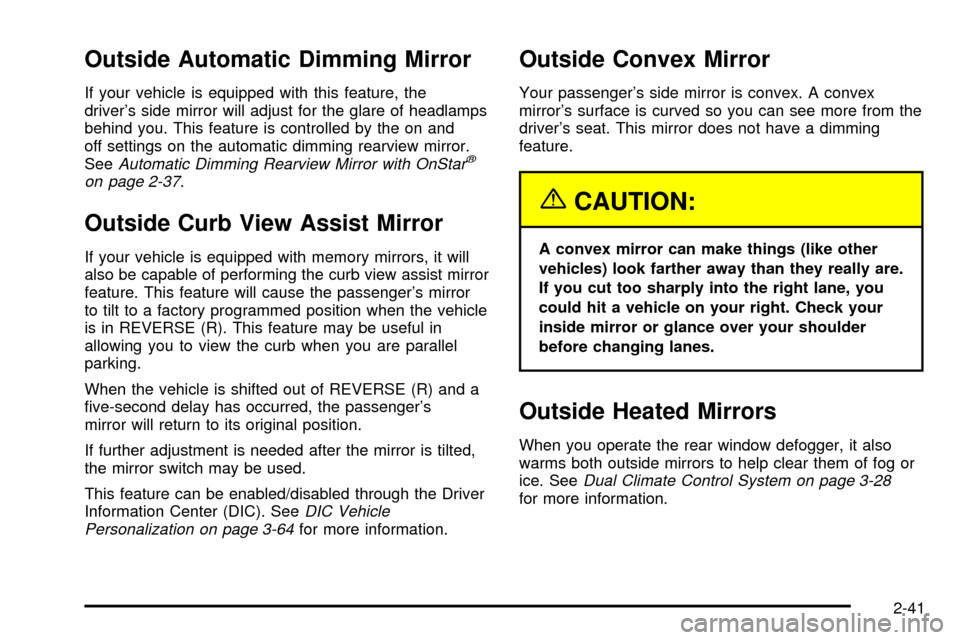2003 CADILLAC SEVILLE lane assist
[x] Cancel search: lane assistPage 101 of 408

Outside Automatic Dimming Mirror
If your vehicle is equipped with this feature, the
driver's side mirror will adjust for the glare of headlamps
behind you. This feature is controlled by the on and
off settings on the automatic dimming rearview mirror.
See
Automatic Dimming Rearview Mirror with OnStarž
on page 2-37.
Outside Curb View Assist Mirror
If your vehicle is equipped with memory mirrors, it will
also be capable of performing the curb view assist mirror
feature. This feature will cause the passenger's mirror
to tilt to a factory programmed position when the vehicle
is in REVERSE (R). This feature may be useful in
allowing you to view the curb when you are parallel
parking.
When the vehicle is shifted out of REVERSE (R) and a
®ve-second delay has occurred, the passenger's
mirror will return to its original position.
If further adjustment is needed after the mirror is tilted,
the mirror switch may be used.
This feature can be enabled/disabled through the Driver
Information Center (DIC). See
DIC Vehicle
Personalization on page 3-64for more information.
Outside Convex Mirror
Your passenger's side mirror is convex. A convex
mirror's surface is curved so you can see more from the
driver's seat. This mirror does not have a dimming
feature.
{CAUTION:
A convex mirror can make things (like other
vehicles) look farther away than they really are.
If you cut too sharply into the right lane, you
could hit a vehicle on your right. Check your
inside mirror or glance over your shoulder
before changing lanes.
Outside Heated Mirrors
When you operate the rear window defogger, it also
warms both outside mirrors to help clear them of fog or
ice. See
Dual Climate Control System on page 3-28for more information.
2-41
Page 243 of 408

If you drive regularly in steep country, or if you're
planning to visit there, here are some tips that can make
your trips safer and more enjoyable.
·Keep your vehicle in good shape. Check all ¯uid
levels and also the brakes, tires, cooling system
and transaxle. These parts can work hard on
mountain roads.
·Know how to go down hills. The most important
thing to know is this: let your engine do some of
the slowing down. Shift to a lower gear when you go
down a steep or long hill.
{CAUTION:
If you do not shift down, your brakes could get
so hot that they would not work well. You
would then have poor braking or even none
going down a hill. You could crash. Shift down
to let your engine assist your brakes on a
steep downhill slope.
{CAUTION:
Coasting downhill in NEUTRAL (N) or with the
ignition off is dangerous. Your brakes will have
to do all the work of slowing down. They could
get so hot that they would not work well. You
would then have poor braking or even none
going down a hill. You could crash. Always
have your engine running and your vehicle in
gear when you go downhill.
·Know how to go uphill. You may want to shift down
to a lower gear. The lower gears help you climb the
hill better.
·Stay in your own lane when driving on two-lane
roads in hills or mountains. Don't swing wide or
cut across the center of the road. Drive at speeds
that let you stay in your own lane.
·As you go over the top of a hill, be alert. There
could be something in your lane, like a stalled car or
an accident.
·You may see hghway signs on mountains that warn
of special problems. Examples are long grades,
passing or no-passing zones, a falling rocks area or
winding roads. Be alert to these and take
appropriate action.
4-25
Page 407 of 408

Towing..........................................................4-31
Recreational Vehicle.....................................4-31
Towing a Trailer..........................................4-35
Your Vehicle...............................................4-31
Traction........................................................... 4-9
Control System (TCS).................................... 4-9
Control System Warning Light.......................3-45
Magnetic Ride Control..................................4-11
Trailer Brakes.................................................4-39
Transaxle Operation, Automatic.........................2-28
Transaxle.......................................................5-21
Fluid, Automatic...........................................5-21
Transmission, Transaxle, Transfer Case Unit
Repair Manual............................................7-10
Transportation Options...................................... 7-8
Trip Computer................................................3-77
Oil Life Indicator..........................................3-77
Trip Odometers..............................................3-39
Trunk Lid Tie Down.........................................2-13
Trunk Lock Release........................................2-12
Trunk............................................................2-12
Turn and Lane-Change Signals.......................... 3-9
Turn Signal/Multifunction Lever........................... 3-9
Turn Signals When Towing a Trailer..................4-40
Twilight Sentinel
ž............................................3-19
U
Ultrasonic Rear Parking Assist (URPA)...............3-24
Umbrella Holder..............................................2-49Underbody Flushing Service.............................6-12
Underhood Fuse Block....................................5-93
Understanding Radio Reception.......................3-103
Uniform Tire Quality Grading............................5-69
United States ± Customer Assistance.................. 7-4
Used Replacement Wheels..............................5-72
Using Digital Signal Processing (DSP)...............3-90
Using HomeLink
ž...........................................2-47
V
Valet Lockout Switch.......................................2-20
Vehicle Identi®cation........................................5-91
Number (VIN).............................................5-91
Service Parts Identi®cation Label...................5-92
Vehicle Personalization....................................3-64
DIC ...........................................................3-64
Memory Seat, Mirrors and Steering Wheel......2-51
Vehicle Speed Limiter......................................3-41
Vehicle Storage..............................................5-44
Vehicle............................................................ 4-6
Control........................................................ 4-6
Damage Warnings........................................... iv
Loading......................................................4-33
Symbols......................................................... iv
Ventilation Adjustment......................................3-33
Visors...........................................................2-18
15